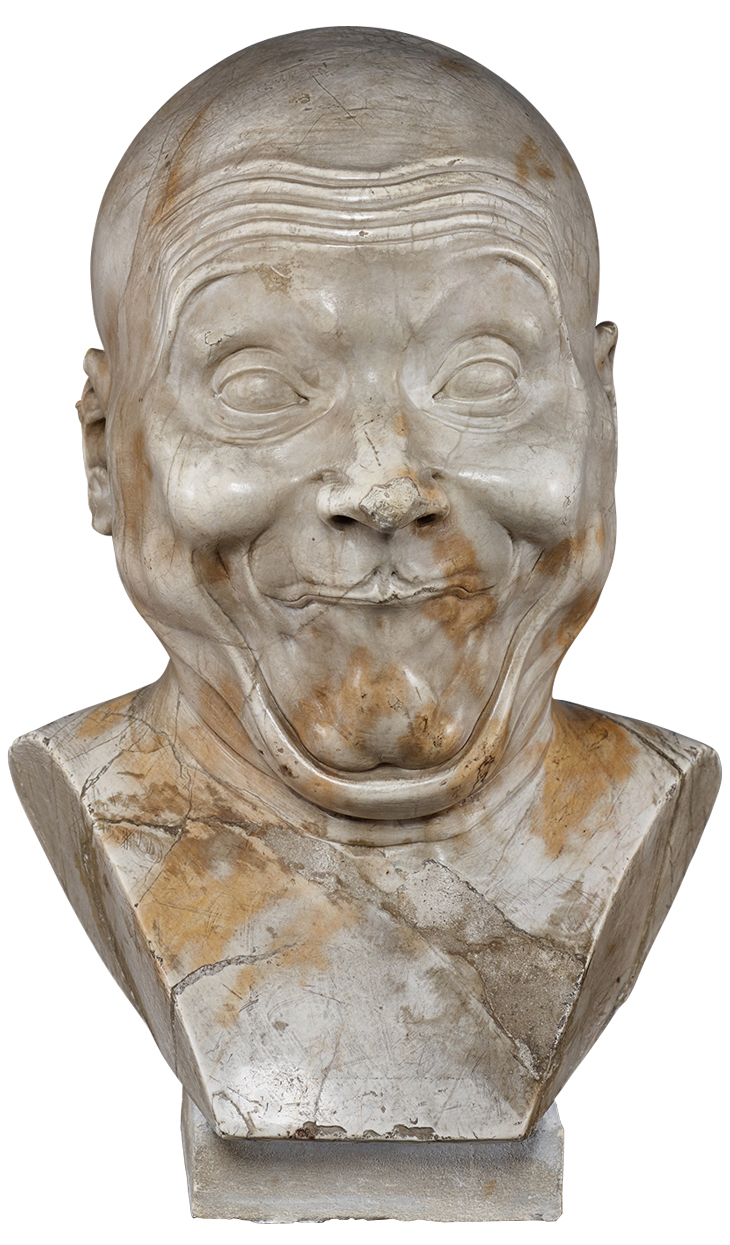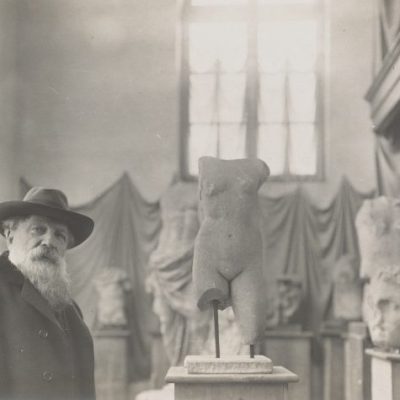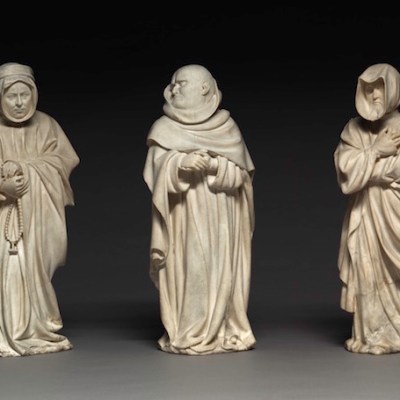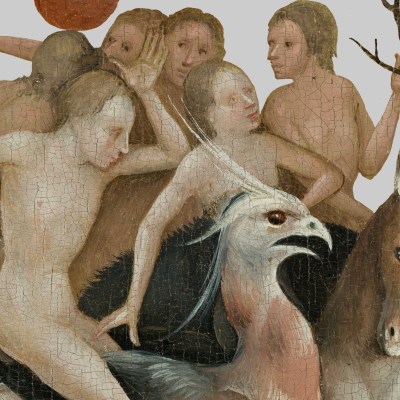In 1781, the sculptor Franz Xaver Messerschmidt (1736–83) cut a strange figure. A decade before, he had been an artist at the heart of Viennese high society. Poised to become professor of sculpture at the Academy of Fine Arts, receiving commissions from Austrian nobility, Enlightenment intellectuals, and from the Empress Maria Theresa herself, he was the city’s most eminent sculptor. But then came some kind of break: his commissions dried up; whispers spread about his sanity; and the Academy chair went to a rival. Paranoid about the ‘very many vexations and injustices that had been done to him’ and convinced that he was the victim of plotting by his rivals, Messerschmidt sold his home and left Vienna. He found himself, for a time, in the wilderness, living alone in a hut in the Swabian mountains, before seeking refuge with his brother in Pressburg – now Bratislava.
When the writer Friedrich Nicolai came to visit him in 1781, Messerschmidt presented the perfect image of the artistic exile. Having sold his possessions, he now lived by himself in a ‘lonely little house’ furnished with nothing more than ‘a bed, a flute, a tobacco pipe, a water jug and an old Italian book on the proportions of the body’. For decoration, there hung in a window ‘a drawing of an Egyptian statue without arms, which he never glanced at without admiration and awe’.
Messerschmidt’s only other company, Nicolai recorded, were 60 of his own creations: busts in alabaster or dull grey metal. Four of these, Nicolai wrote, were ‘truly admirable masterpieces’, self-portraits ‘conforming with nature’. Of his two favourites, one showed the artist laughing so heartily that his teeth, palate and tongue were visible ‘down to the root’; the other showed him ‘very serious in the ancient style’. These, Nicolai thought, revealed Messerschmidt’s genius. All the others, he simply found disturbing. ‘One saw in them, really,’ he wrote, ‘what wretchedness human art brings forth when it seeks to create something supernatural.’
Messerschmidt’s Character Heads, in a lithograph of 1839 by Matthias Rudolph Toma. Österreichische Nationalbibliothek, Vienna

The Character Heads, as they have come to be known, are now the core of what later generations have seen as Messerschmidt’s genius. Busts with wildly distorted faces, the 49 surviving heads crafted from c. 1770 through to Messerschmidt’s death are unlike any other sculptural group ever made. Some have their chins and necks pressing deeply down as if attempting to withdraw between their collar bones; others crane up and out until the sinews tauten in lines of force that seem to stretch out beyond the slim section of body represented. All of them bear expressions as extreme as they are inscrutable: every wrinkle scribed with unnatural precision and depth to create an effect that is simultaneously hyper-realist and utterly unreal.
When Nicolai visited Messerschmidt there were 56 heads, and it seems that the artist intended to craft 66 altogether. Fifty-four were part of an incomplete project to set down the ‘sixty-four variations on the grimaces’ of the human face. They would also, Messerschmidt intimated, represent ‘the supernatural senses of animals’. When completed, the group would, it seems, form an apotropaic system warding off an evil that Messerschmidt believed was stalking him.
The Yawner (front view; c. 1770–83), Franz Xaver Messerschmidt. Museum of Fine Arts, Budapest

From the sculptor’s behaviour towards the remaining two heads, Nicolai divined that they depicted this evil. While Messerschmidt looked on the other heads with the greatest satisfaction, he ‘only briefly glared’ at these, ‘then immediately turned his head aside’. The busts had faces jutting forward, their features crammed in towards the centre and then drawn out so that the lips resembled ‘the form of a bird’s beak’. It transpired that they were images of an apparition that came and tortured Messerschmidt at night – an apparition that Messerschmidt believed to be the ‘Spirit of Proportions’. When asked for more detail, Messerschmidt gave only the gnomic answer that ‘He […] had pinched him and he pinched him in turn, until the figures came out.’
Nicolai’s portrait of Messerschmidt is compelling: an artist in the grip of delusion, wrecking his present with the monomaniacal pursuit of the project that would ensure his posterity. He died two years after Nicolai’s visit, aged only 47 – his death hastened, according to the writer, by the destructive effects of ‘disordered endeavour and intellectual derangement’ on a ‘naturally sound constitution’. He was, in short, a tragic romantic genius, of a type that Nicolai – who had written a successful parody of Goethe’s Sorrows of Young Werther – knew very well.
Looking at the Character Heads, it would seem contrarian to believe anything else. They so clearly appear to be the work of an artist in pursuit of something private, mad, unique, that Nicolai’s invisible spirits and paranoiac isolation make total sense. And they seem, too, perfectly to represent the liminal state – neither entirely cut off from nor fully accessible to human reason – in which Nicolai found Messerschmidt himself. It is an uncomfortable place, in which the viewer is confronted with arrangements of features that are instantaneously recognisable as faces, and which stimulate the same empathetic responses that faces stimulate, but which defy the normal interpretative framework of those responses.
Second Beaked Head (1777–81), Franz Xaver Messerschmidt. Photo: © Belvedere, Vienna

Among the more extreme examples of this paradox is the Second Beaked Head, briefly described by Nicolai. This alabaster bust makes uncomfortably fleshy use of the stone’s veining and staining, and uncomfortably stony use of human features – in such a way that it almost flickers between the two as you look at it. Focus on the lower half, and it could be an anatomical model: as the neck cranes up, its sinews are drawn into tight lines that gradually blend into the iron oranges of the upper chest, exaggerated but recognisable. Stretch your own chin up and forward, and the same sinews appear, along with that smooth, fat wrinkle running round the back of the neck. The same realism appears in the tightly clenched eyes. But then the rest of the face, with its incised parallel lines on the cheeks, and the inhuman protrusion of the ‘beak’, belongs to impossibility.
Despite this, the sculpture still stimulates the attempt to make sense of it in terms of human expressions. In profile, it might be wearing a caricature sarcastic grin; front-on, it might be puckering for a kiss. Both cannot make sense at once. Then there is the tension of the whole form. Is that astonishing crane of the neck an attempt to flee or intrude? Some grand exertion is occurring, but it is unclear whether the efforts are invasive or evasive, or somehow both. Examine the bust at length and Messerschmidt’s description of being pinched by the spirit and pinching it back begins to make sense.
Childish Weeping (c. 1770–83), Franz Xaver Messerschmidt. Museum of Fine Arts, Budapest

The unreadability of the Character Heads has been an issue from the first moment they passed into the public domain. In 1793 an anonymous writer identified only as ‘the author of the forthright letter on sheep husbandry in Bohemia and Austria’ published The Curious Life History of Franz Xaver Messerschmidt. Along with the sculptor’s life story, the author gave the 49 Character Heads the names they still carry today; names that bear testament in roughly equal measure to the desire to pin them down, and the impossibility of doing so. Some are directly descriptive, but fall beside the mark. Childish Weeping seems, with its wide open eyes, less to be snivelling than expressing, all at once, surprise, fear, and distaste; The Yawner could just as well be screaming. Other names are character interpretations – A Mischievous Wag, A Know-It-All Quibbling Quipster – but these seem almost random in nature. What precisely made the Life History’s author take the bowed head of bust number 39 for A Hypocrite and a Slanderer rather than a penitent, or even a man holding in a laugh? Others give similarly haphazard narrative backgrounds – The Enraged and Vengeful Gypsy, The Incapable Bassoonist – but here too, when confronted with the actual busts, the whimsy thuds to the ground.
The Life History’s author knew the limitations of his labels. Apparently less forthright about sculpture than Bohemian sheep husbandry, he encouraged ‘connoisseurs’ whose ‘research into expressions’ led them to better titles to send them to him. He knew he had fallen short of solving the Character Heads’ enigmas, even if he had faith that they could, by diligent research, be explained and elucidated. It bears testament to the interpretative challenges of the heads that, despite critics’ best efforts, the old names have never been supplanted. As Shakespeare’s Duncan might say, there is no art to find the mind’s construction in these faces.
A Mischievous Wag (1777–83), Franz Xaver Messerschmidt. Photo: © Belvedere, Vienna

It is not surprising, then, that over the years, many interpreters of Messerschmidt’s heads have fallen back on madness as their explanation. Since the early 20th century, art historians, doctors, and psychologists have been retrodiagnosing Messerschmidt with conditions from Crohn’s disease to lead poisoning, narcissism, and paranoid schizophrenia. It is, though, unclear what use such diagnoses have beyond turning sculpture into pathology: finding a means of explaining away the Character Heads by confining them to a world beyond the rational or interpretable.
There have been corresponding efforts to rescue Messerschmidt from madness – by giving the heads a satirical motivation, or aligning them with the pseudoscience of contemporary physiognomy, or by questioning Nicolai’s account altogether. All these are possible, and there are certainly elements of Nicolai’s account that seem almost too good to be true. What, for instance, should we make of that unfurnished home, when the household inventory compiled just after Messerschmidt’s death shows it was full, prosperous, and apparently normal?
Similarly, just because you are paranoid does not mean they are not out to get you. As Nicolai himself noted, ‘All academies are hotbeds of dispute and petty intrigue’, and Vienna was no exception; at least some of Messerschmidt’s paranoia seems quite justified. Hans Rudolf Füssli (brother to the more famous Henry Fuseli) studied alongside Messerschmidt, and remembered that there were indeed ‘frequent cabals against him’. It is easy to imagine, at least, that Messerschmidt’s wounded pride and lonely exceptionalism might have had their origins in real intrigues against him.
For all this, though, there can be no real doubt that Messerschmidt’s delusions outpaced any roots in actual physical circumstance. He did, it can hardly be denied, go mad; and it was out of that madness that the Character Heads poured. And yet, madness is itself historically contingent: it depends for its forms on the material given to it by specific times and places. Messerschmidt’s madness took a form that it could only have taken in the 18th century. While he seems to have given his delusions their own flavour, Messerschmidt was far from the only believer in spirits, animal senses, and mysterious influence to be found in 18th-century Europe. Nicolai recorded that ‘people who boasted secret knowledge […] and mastery over the forces of nature’ were to be found all over the continent, and believed that Messerschmidt represented the effects of such fantasists on a strong but ‘ignorant’ mind.
A Hypocrite and a Slanderer (c. 1770–83), Franz Xaver Messerschmidt. Metropolitan Museum of Art, New York

Nicolai aimed his barbs at those who peddled ‘secret knowledge of invisible spirits’, but 18th-century magical thinking was a far broader category. The growth of recognisably modern approaches to epistemology, moral philosophy, and science that earned the era its label as the ‘Enlightenment’ was accompanied by a corresponding uptick in pseudo-science, spiritualism, and other varieties of universal systematisation. Purporting in their different ways to unlock the mysteries of being and the order of the universe, the two sides of Enlightenment thought were often symbiotic too. The facts of the former – the products of scrying into the mysterious forces of gravity, electricity, and magnetism – fed the delusions of the latter; and the same delusions often, in return, directed and focused genuine enquiry.
In Vienna, Messerschmidt had ample opportunity to sample all the Enlightenment’s eddying currents of method and madness, but he appears to have been close to one in particular. In March 1770, at the height of his career, Messerschmidt purchased a house in the suburb of Landstrasse, and entered the orbit of one of the area’s better known residents: Franz Anton Mesmer. A bust Messerschmidt made in the same year shows his new neighbour in the neoclassical style that befitted his dignity as a doctor and philosopher. Stately, plump and benign, it is the face of the progenitor of one of the most famous theories of the age: animal magnetism.
In 1766, Mesmer had published an elaborate synthesis of various current theories of the interaction between organic and cosmic bodies titled Of the Influence of the Planets upon the Human Body. From these, Mesmer elaborated his magnetic doctrine – a discovery that offered the possibility of a true panacea, both for individual men and for mankind as a whole. Mesmer stated that a universal and intangible fluid permeated all things, transmitting forces between them, so that influences could pass from one ‘organised body’ to another. Such influences included the tidal effects of the planets on humans, but also the less evident effects of humans and other organisms on each other. The healthy body was pervious to the magnetic fluid, which could flow through its poles uninterrupted; the sick body provided an impediment, which was itself the sickness. This could be cured, however, by scientific application, over many sessions, of ‘magnetisation’ at the hands of a skilled magnetiser.
It is unclear whether Mesmer was a deliberate fraud or genuinely convinced of his powers; and to modern ears, it all sounds like so much nonsense. But there is no doubt that he helped some of his patients, even if unwittingly. Mesmer’s cures ranged from relieving colic to alleviating blindness, and even when total rehabilitation was not achieved, something was clearly happening. Mesmer’s séances exposed patients to music, elaborate paraphernalia, and quasi-ceremonial movements over several hours. Eventually, many of those on the receiving end fell into ‘magnetic crises’: contagious convulsions and fits, deep catatonic states, and, often, wild facial contortions. They were, as it was later called, mesmerised.
Many, at least temporarily, found relief from their problems. In addition to the placebo effect of the supposed ‘magnetism’, the fact that Mesmer was giving no actual treatment was probably in his favour. Medicine was still so primitive in the 18th century that conventional cures were at least as likely to cause harm as good. Mesmerism, for all the spectacle of its ‘crises’, did not create the iatrogenic illnesses that made other treatments actively harmful.
Mesmer magnétisant une patiente (1784), unsigned. Bibliothèque nationale de France, Paris

Mesmer was well placed for animal magnetism to be taken seriously. His house and garden on the Landstrasse were a centre for Vienna’s intellectual and artistic society. There, in sight of a now lost fountain sculpted by Messerschmidt in 1770, he hosted concerts by Haydn, Gluck, and the young Mozart. Occasionally, he even offered his own contributions on his ‘glass armonica’ – a fashionably exotic instrument invented by Benjamin Franklin in 1761. Credited by its inventor with healing powers, it would fall out of fashion after rumours spread that its ethereal tones in fact exerted strong effects on the nerves, causing melancholia and madness.
Animal magnetism became one of the great fads and controversies of the age. Harried out of Vienna by an unimpressed medical establishment, Mesmer took his cures to Paris. Regardless of the debunking his theories received from a specially convened royal commission in 1784 – which included none other than the American ambassador to France, Benjamin Franklin, inventor of the healing-harming harmonica – he found success there. As late as the 20th century, Mesmer’s theories retained a certain currency in France; enough for Georges Méliès to lampoon them in his silent short Le baquet de Mesmer (1905).
It is tempting to trace direct influence from Mesmer in Messerschmidt’s Character Heads, and critics have. It is hard, knowing Mesmer’s story, not to see something of his theories in them. The loose cord wrapped around the neck of the visibly misnamed Hanged Man may be one of the magnetised ropes used in Mesmer’s séances; and the expressions of the whole series may in some way be inspired by the convulsive results of ‘magnetic crises’. Despite the persistent story that the sculptor and the doctor lived together for a time, however, there is no evidence that Messerschmidt and Mesmer were personally close. If Mesmer did influence him, it is clear that Messerschmidt filtered his ideas through his idiosyncrasies, and – to judge by Nicolai’s record – an eclectic assemblage of other current ideas. Certainly, between Lavater’s physiognomy, Egyptian-flavoured hermeticism, and the many theories of proportion that took man as the measure of the universe, Messerschmidt had plenty of material to draw on.
The idea that any one species of 18th-century methodical madness can provide a key to the heads, though, is less important than the world that, taken together, such theories limn. It was a world in which many believed in different varieties of spooky action at a distance, and in which quackery and magical thinking were often indistinguishable from science. In this context, Messerschmidt’s illness and art alike, for all the individuality of their expression, are of a kind with his time. In the report of the royal commission on animal magnetism, published a year after Messerschmidt’s death, such ideas become, in some sense, scientific fact. Mesmer’s miracles did, the investigators argued, demonstrate the possibility of action at a distance. Only rather than magnetism, such action was conveyed by the imagination alone. ‘Man,’ one commissioner wrote, ‘can act upon man, at any moment, and almost at will, by striking his imagination; […] the simplest gestures and signs can have powerful effects […] on subjects who have faith.’ Messerschmidt might well have considered himself vindicated.
From the March 2018 issue of Apollo. Preview and subscribe here.


